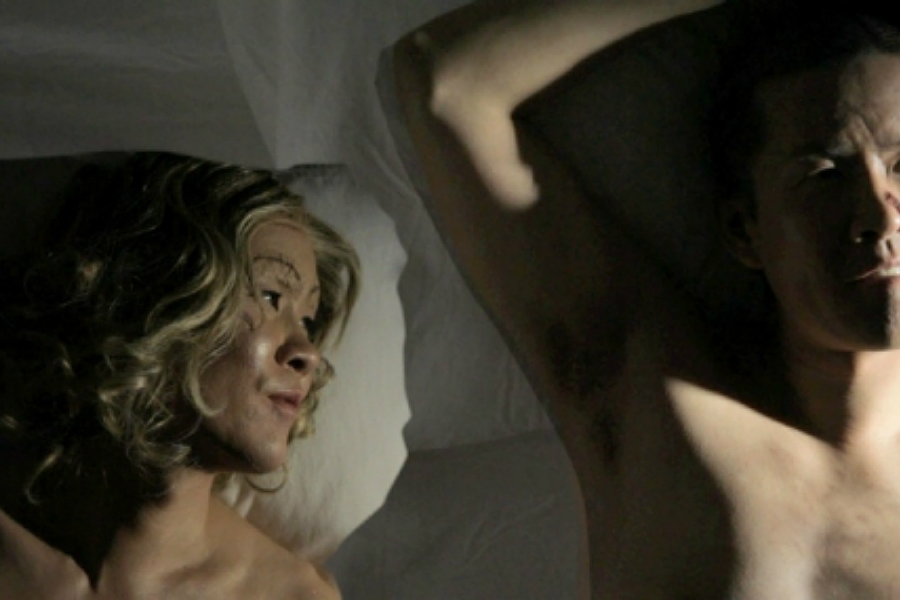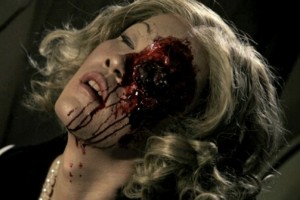Ming Wong’s Making Chinatown – Reviewed

Themes can occasionally become obstacles for artists and their work. How would Ming Wong fair?
The line between parody and pastiche can sometimes appear a very thin one indeed, blurry at best. And at first glance Ming Wong’s offering for the Biennial’s Unexpected Guest, if anything, seems to fall into the camp of the latter.
Stepping through the make-shift curtains into 28-32 Wood Street (the site of the old Open Eye Gallery) you are instantly transported. To where, you’re not immediately sure; it’s a little disorientating, confronted as you are by a pair of projection screens, and one more behind and to your left.
For anyone familiar (or not, we suppose) with Roman Polanski’s neo-noir masterpiece Chinatown, this is where the fun begins. Watch for a little while and you begin to pick out iconic lines and scenes from the movie starring Jack Nicholson and Faye Dunaway, except here we have the Singaporean artist Ming Wong performing their (and John Huston’s) roles.
What’s it all about? Making Chinatown, a piece commissioned by LA’s Redcat Studios, in which Ming Wong – fascinated by depictions of national identity in Hollywood – deconstructs brilliantly, through language and performance, the iconic movie before our eyes. Forgetting the playful element for a moment though, in no way is this all merely a pastiche of a memorable piece of cinema; there is clearly much more at play here.
As a viewer familiar with the original, it is both playful and perplexing – for a person who claims he has no designs on ‘serious’ acting, he makes for a much better Dunaway than anybody has any right to. In a recent talk given at the Bluecoat, the artist explained that, for him, it is “more about myth making… than it is acting… the strategy is to role play somebody opposite oneself – in gender, class and character”.
In addition to the impeccably re-enacted movie – right down to the casting of extras whose appearance is close to those of the original – all around are cut-outs (produced, on the face of it, to Hollywood standard) from Ming Wong’s production.
Hands down, already, Ming Wong’s is a contender for our favourite piece in this year’s Biennial, but there is still more to explore. Commissioned especially for the Biennial is another video installation entitled After Chinatown. Purportedly dealing more closely with the Unexpected Guest theme, this piece instead is somewhat more esoteric.

Wong is once again in drag (and more than one role), but this time, without a familiar narrative to guide us there is less clarity. The result is disarming and beguiling, producing a dreamy kind of feeling in the viewer. A colleague was so impressed they remarked that Chinatown’s distributor should package it all up as a special DVD release along with the original. He was only half joking.
Last but not least, at the end of the space in a separate room, is The Chinese Detective. It amounts to a wonderful and revealing collection of movie paraphernalia through the years with an emphasis on the clichéd casting of ‘Chinese’ people. From Western actors filling roles in the past to very recent – but no more modern – depictions of what it is to be ‘Asian’ on film (take an ironic bow, Kill Bill), The Chinese detective is both a cineaste’s joy and shame.
Much like the three elements in this exhibition in fact. Viewed together and in repose, they amount to an indictment of Western perceptions, but we’d hazard a guess that while Ming Wong would want to draw attention to the troubling realities of casual racism, he is just as interested in playing with concerns in a humourous, ironic way.
In any case, and whatever conclusions you draw from Making Chinatown, et al, we’d urge you to see it for the simple fact that it so successfully and artfully grapples and engages with the central theme of Biennial 2012.
All images from Making Chinatown and courtesy Redcat





